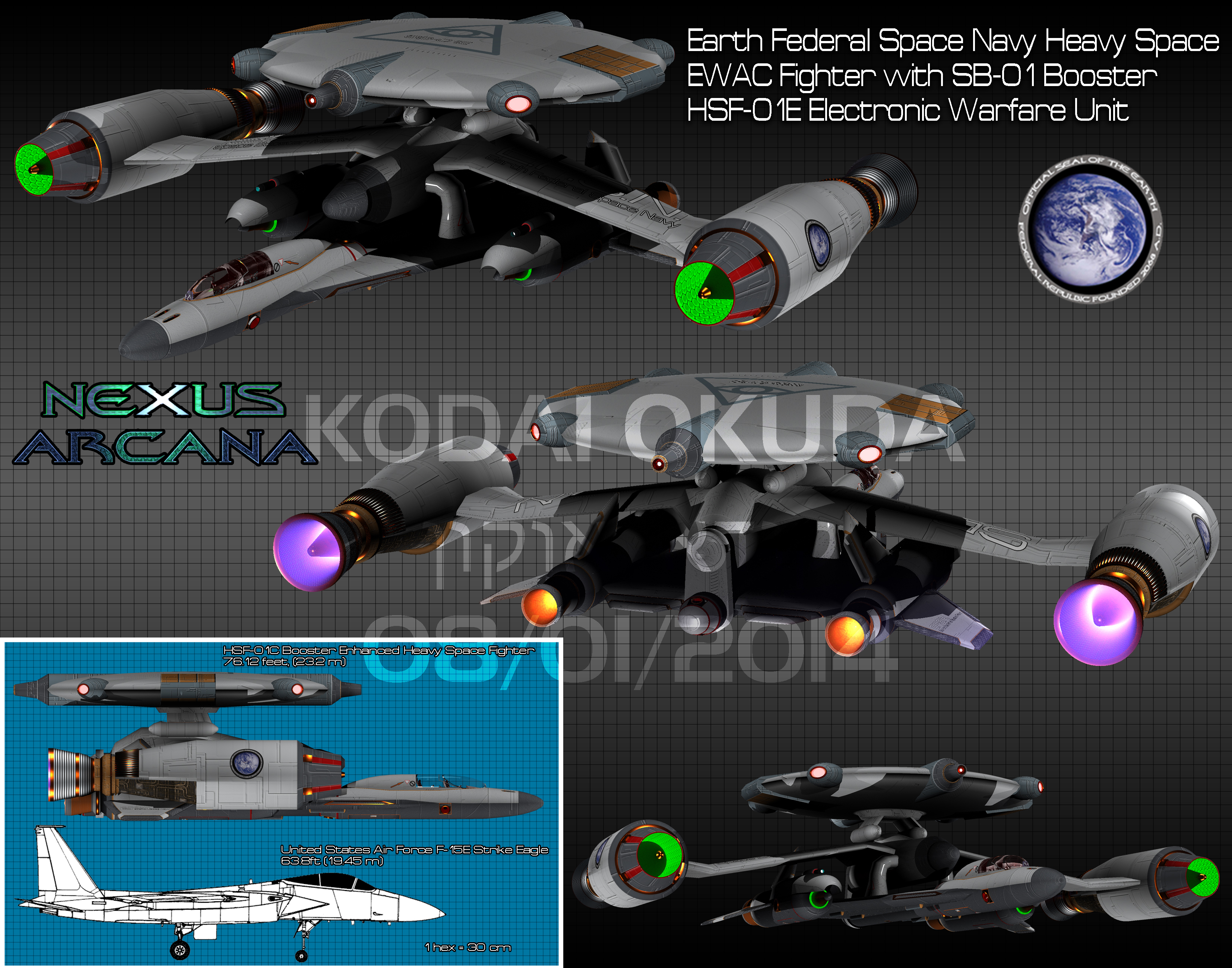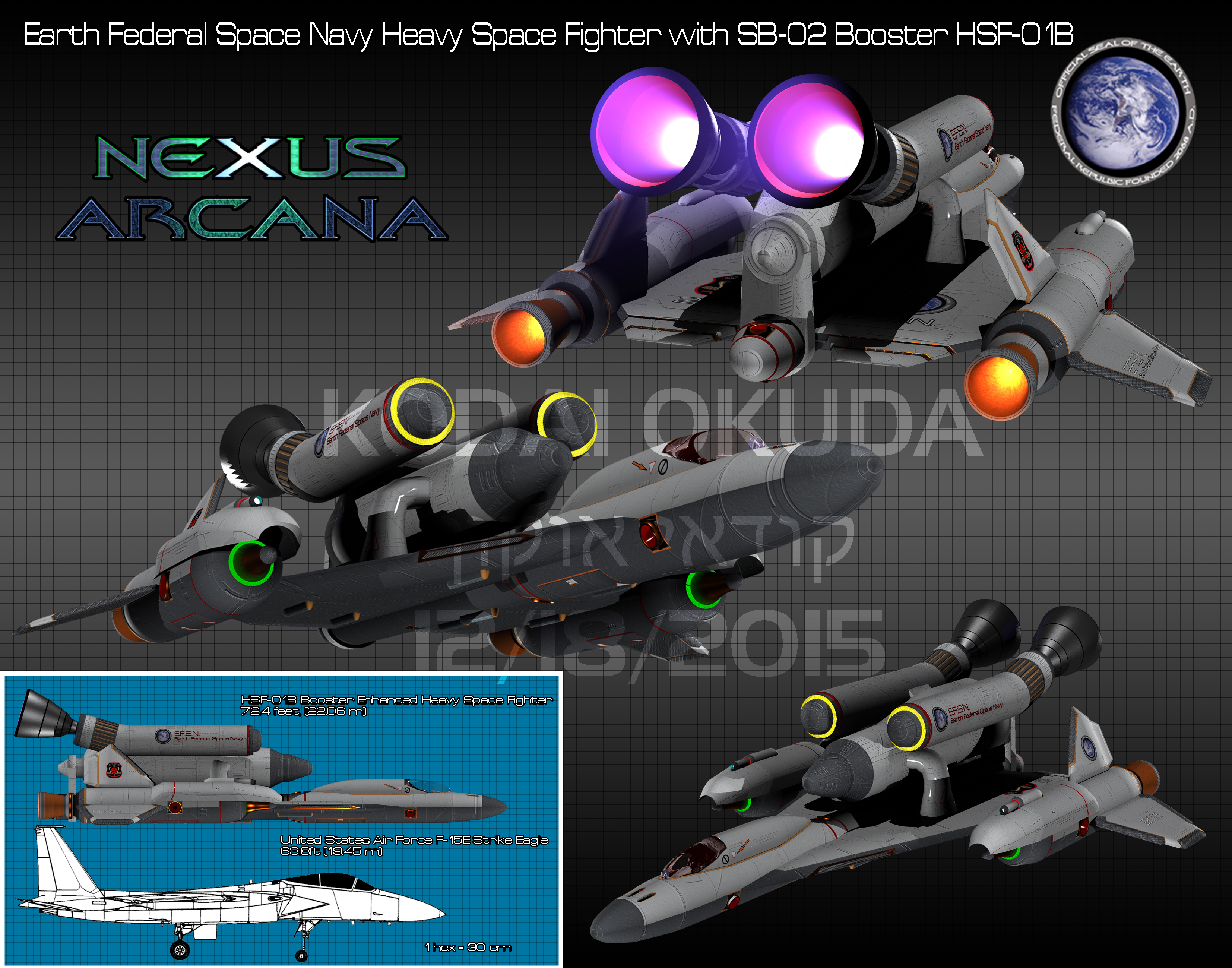 |
||
 |
||

HSF-01E
GOVERNMENT: Earth Federal Republic
TYPE: Heavy Space Superiority Fighter
MODELS: Lokheed HSF-01D "Double" with Warptron SE-01 Electronic Warfare system equipped
DATE INTRODUCED: 2171 A.D. (HSF-01D), 2173 A.D. (SE-01)
LENGTH: 76.12 feet, (23.2 m) with booster
WIDTH: 50.8 feet (15.5 meters)
HEIGHT: 21 feet (6.4 meters) with booster
BOOSTER DIMENSIONS:
(SB-01 Booster)
Battle Section: 49.9 feet long (15.2 meters) x 86.3 feet wide (26.3 meters) x 21 feet high (6.4 meters)
MATERIAL:
Composite-Alloy
Crystal Composite
POWER PLANT:
Federal Energy FEFR-350 (Fighter)
Federal Energy FEFR-175 (booster reactor)
OUTPUT:
350 megawatts
175 megawatts (boosters only)
ARMOR TYPE:
Crystal Composite (all models)
ARMOR THICKNESS:
2 inches (fighter)
2 inches (booster)
DISPLACEMENT:
50 tons (fighter)
20 tons (booster only, 70 tons total with fighter)
CREW: 2 (1 Pilot, 1 Co-pilot/Electronic Warfare Officer)
PROPULSION
PRIMARY (FLIGHT):
2x Rocketdyne FT-25 fusion thrusters
SPEED: 76,000 mph each (152,000 mph total)
BOOSTER ENGINES:
2x Bohing PLD-01 Plasma Drives
SPEED: 760,000 mph each (1,520,000 mph total)
WEAPONS:
PRIMARY (OFFENSIVE):
4x Lunar Dynamics LD-PLC-10 10-megawatt pulse laser cannons (2 on HSF-01D, and 2 on Booster); Effective Range: 100 miles; Payload: unlimited with 100-megawatt nuclear battery clutch; ROF: bursts of 2, 5, or 10 blasts per cannon with a cyclic rate of 60 blasts each per minute or 120 blasts per minute total from both cannons.
SECONDARY (OFFENSIVE):
The fighter was able to hold up to 20 tons of bombs and missiles externally. There were three hard points under each wing (1 forward next to the aft section of the cockpit, and two side by side under the wing next to the inside of the engine nacelle) and one hard point on the centerline of the fuselage, for a total of 7 hard points. The standard outside ordinance payload normally consisted of 12, SST-1M, 1000-pound short-range space torpedoes (2 torpedoes on each hard point except the center hard point, which was left empty). After 2173 AD, the payload became 6, MST-1M 1000lb medium-range space torpedoes (one on each hard point except the center) and a pair of Bohing/MMI M230-AC-GP gunpods mounted side by side, facing forward, on the center hard point. This configuration was used up until 2225 AD, when the HSF-01 was retired from service.
ELECTRONICS:
1x Laser Communications array with a 10 AU range.
1x Passive EMS array with a range of 100,000 miles.
1x Active EMS array with a range of 1000 miles.
1x Gravitational Control/Antigravity unit Effect: provides artificial lift,g-force compensation and enhanced maneuverability.
(SFB-01)
Both boosters have an antigravity unit
(SFB-01 ONLY)
1x RADAR array with a range of 5000-miles.
DEFENSE SYSTEMS:
6x Militia Military Industries ND-5 5-megawatt nuclear dampener generators; RANGE: 2540 feet; Effect: Random due to numerous variables. In general, the nuclear dampeners provided moderate to considerable resistance to energy weapons and were able to cause missile warheads to either explode or go inert within its area of effect.
Description/Overview:
(HSF-01E)
This variant of the HSF-01B was built in 2073 AD for operation “Clean Sweep” by the newly established Warptron Company at the EFSM space station Nowhere Station. Essentially, the HSF-01E was identical to the HSF-01B except that the “battle section,” which contained the targeting RADAR and beam cannons, was replaced by an EWAC dish. This dish contained the most advanced electronic systems of its day and could act as both the standard and the jamming type communications and sensor equipment. This EWAC suite gave the HSF-01E booster system unparalleled electronic warfare capabilities.
The majority of HSF-01Es were built during the 1st Interplanetary War with a total of 8000 units by war’s end, although an additional 1500 units were constructed during the interim period of reconstruction between the 1st Interplanetary War and the Ceres Conflict. These additional units were built to help track down and apprehend the UN and EFF spacepirates that plagued the space ways of the Sol System. By the time the Ceres Conflict broke out, nearly 10,000 had been produced.
The HSF-01E was used almost exclusively with the HSF-01D twin-seat model of heavy space fighter. The “two-seater” was used so that the pilot could fly the HSF while the copilot/sensor operator could focus on the EWAC sensor suite of the craft.

HSF-01B
GOVERNMENT: Earth Federal Republic
TYPE: Heavy Space Superiority Fighter
MODELS: Lokheed HSF-01 with Norking SB-02 (space booster) improved-booster system equipped HSF-01: Designated HSF-01B
DATE INTRODUCED: 2173 A.D. (SFB-02)
LENGTH: 72.4 feet (22.06 meters) with booster
WIDTH: 50.8 feet (15.5 meters)
HEIGHT: 12.8 feet (3.9 meters) with booster
BOOSTER DIMENSIONS:
Engine Pods: 37 feet long x 6 foot diameter
Main Body: 40.5 feet wide x 7 foot diameter
MATERIAL:
Composite-Alloy (fighter)
Crystal Composite (booster)
POWER PLANT:
Federal Energy FEFR-350 (Fighter)
Federal Energy FEFR-150 (booster)
OUTPUT:
350 megawatts
150 megawatts
ARMOR TYPE:
Crystal Composite (both fighter and booster)
ARMOR THICKNESS:
2 inches (fighter)
2 inches (booster)
DISPLACEMENT:
50 tons (fighter)
20 tons (booster only, 70 tons total with fighter)
CREW: 1 (1 Pilot)
PROPULSION
PRIMARY (FLIGHT):
2x Rocketdyne FT-25 fusion thrusters
SPEED: 76,000 mph each (152,000 mph total)
BOOSTER ENGINES:
2x Bohing PLD-01A Plasma Drives
SPEED: 760,000 mph each (1,520,000 mph total)
WEAPONS:
PRIMARY (OFFENSIVE):
2x Lunar Dynamics LD-PLC-10 10-megawatt pulse laser cannons (2 on HSF-01); Effective Range: 100 miles; Payload: unlimited with 100-megawatt nuclear battery clutch; ROF: bursts of 2, 5, or 10 blasts per cannon with a cyclic rate of 60 blasts each per minute or 120 blasts per minute total from both cannons.
SECONDARY (OFFENSIVE):
The fighter was able to hold up to 20 tons of bombs and missiles externally. There were three hard points under each wing (1 forward next to the aft section of the cockpit, and two side by side under the wing next to the inside of the engine nacelle) and one hard point on the center line of the fuselage, for a total of 7 hard points. The standard outside ordinance payload normally consisted of 12, SST-1M, 1000-pound short-range space torpedoes (2 torpedoes on each hard point except the center hard point, which was left empty). After 2173 AD, the payload became 6, MST-1M 1000lb medium-range space torpedoes (one on each hard point except the center) and a pair of Bohing/MMI M230-AC-GP gunpods mounted side by side, facing forward, on the center hard point. This configuration was used up until 2225 AD, when the HSF-01 was retired from service.
ELECTRONICS:
1x Laser Communications array with a 10 AU range.
1x Passive EMS array with a range of 100,000 miles.
1x Active EMS array with a range of 1000 miles.
1x Gravitational Control/Antigravity unit Effect: provides artificial lift,g-force compensation and enhanced maneuverability.
(SFB-01)
Both boosters have an antigravity unit
(SFB-01 ONLY)
1x RADAR array with a range of 5000-miles.
DEFENSE SYSTEMS:
6x Militia Military Industries ND-5 5-megawatt nuclear dampener generators; RANGE: 2540 feet; Effect: Random due to numerous variables. In general, the nuclear dampeners provided moderate to considerable resistance to energy weapons and were able to cause missile warheads to either explode or go inert within its area of effect.